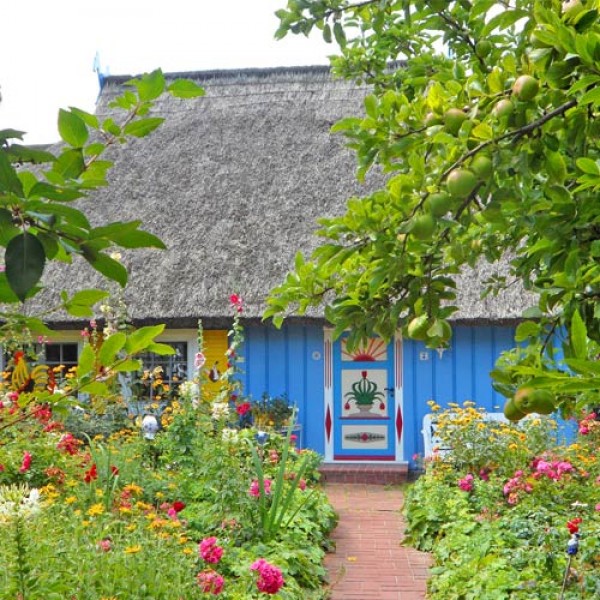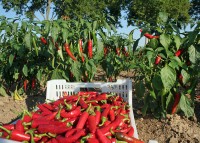Do it yourself - farm garden
Wild, romantic, colourful - the cottage garden, which in the 19th century was laid out by farmers or at monasteries, is now a popular way of gardening.
After all, gardens were often limited in the past, which seems familiar again nowadays...
In those days, useful plants, medicinal herbs and some ornamental plants should find a place in the garden, too.
It wasn`t easy all the time, but the plants lived in perfect unity and produced a harvest all year round.
We explain how to set up a cottage garden correctly, what to look out for and which flowers and plants are an essential.
How is the cottage garden arranged?
The cottage garden is based on a rectangular shape, which is divided in the middle by a fountain and further decoration as a central point. From the fountain, a path cross goes through the garden and divides the garden into 4 beds of the same size.
A path also leads around the entire square of the cottage garden.
In this way, each bed can be reached from each side.
In the history of gardens, the farm garden was always separated with simple slats so that hungry wild animals could not steal the valuable harvest. Each individual bed or plot was then further protected by a border as well, which usually consisted of a smaller fence or hedge.
The paths leading through the cottage garden were and are generally not sealed.
Unsealed paths are close to nature and allow water to seep in better.
Bark mulch, gravel, pebbles or even water-permeable natural stones serve as the basis for paths.
A cottage garden is always located in close distance to the kitchen and should be oriented towards the east or south in order to produce the best harvest. If one side of the garden is towards the house, by the house or by a wall, the garden remains protected from draughts or cold currents. As an alternative to the wall, however, a larger hedge can also be planted.
Which plants live in the cottage garden?
In earlier times, the garden was not for leisure but for self-sufficiency, so robust, long-lived plants had to be grown in the garden. Flowers such as the columbine, hollyhock, lily or peony were often planted here to characterise the colourful gardens.
To make the garden pretty as well as to protect it from pests such as caterpillars or aphids, rue, summer savory or nasturtium were often sown. Other flowers such as marigold were sown against nematodes (threadworms). Only flowers like jewelweed or poppies were grown for decoration.
In the case of climbing plants, the focus was on beans and pumpkins, which were beautiful and useful at the same time and usually grew on wooden climbing arches.
Medicinal and culinary herbs were also found in the cottage garden, growing side by side in harmony. Most herbs were planted at the same time for their medicinal properties as well as for their taste in food. Herbs that were planted in the cottage garden are: Rosemary, sage, marjoram, camomile, marshmallow, motherwort, yarrow, St. John`s wort and lemon balm.
Herbs like mint tended to be grown in pots for propagation. Soup herbs like lovage, celery, chives or even parsley were placed in the nutrient-rich soil of the garden. For thyme, rosemary, oregano or sage, the soil was mixed with gravel or sand.
Vegetables and fruit in a cottage garden?
In a cottage garden, fruit and vegetables are grown in a mixed culture. Even the gardeners of that time knew exactly which plants complement each other well and which ones keep various pests away from other plants.
Here, some tricks were used:
- onions were planted between carrots to keep the carrot fly away
- Garlic was planted between tomatoes, cucumbers or strawberries to prevent fungal diseases.
- Tomatoes were planted near cabbages to keep the cabbage whitefly away and the other way round the cabbage was used to keep the leaf spot disease away from the tomatoes.
What fruits and vegetables are planted in the cottage garden depends on the gardener. You should grow the fruits and vegetables that you like and use often. The possibilities for cultivation here are nearly endless.
The cottage garden today?
Today`s cottage garden is more of an example and less of a useful garden. However, as the creation of such a colourful and versatile garden is very expensive, many gardeners work with home-grown plants and additionally decorate with planted clay pots, fruit crates or jugs. Even wheelbarrows, vintage cars, old bathtubs and co. are often integrated as decoration and planters in cottage gardens.
Which plants still have to be part of the cottage garden today?
- The hollyhocks, which are popular in Germany, especially in the north.
- Lupins, which are great food for bees and very colourful.
- Marigolds, which are beautiful and can also help against gastro-intestinal or menstrual problems.
- Watercress, which serves as a strong seasoning herb
- Zinnias, which are also ideal for beginners
- Lady`s mantle, which can be used as a medicinal herb against ulcers, inflammations or skin problems.
- Marigolds ("Tagetes"), which can be used as a seasoning for desserts or salads.
- peonies, which have an intense smell
- The watering heart, with its wonderful form and blossom.
But other flowers such as sunflowers, carnations, foxgloves, bellflowers, forget-me-nots, vetches, delphiniums, snapdragons, mallows, fat hens, pasque flowers, Christmas roses, daisies, violets should also be used to complement the variety of flowers and preserve the wild romantic style of the cottage garden.






















